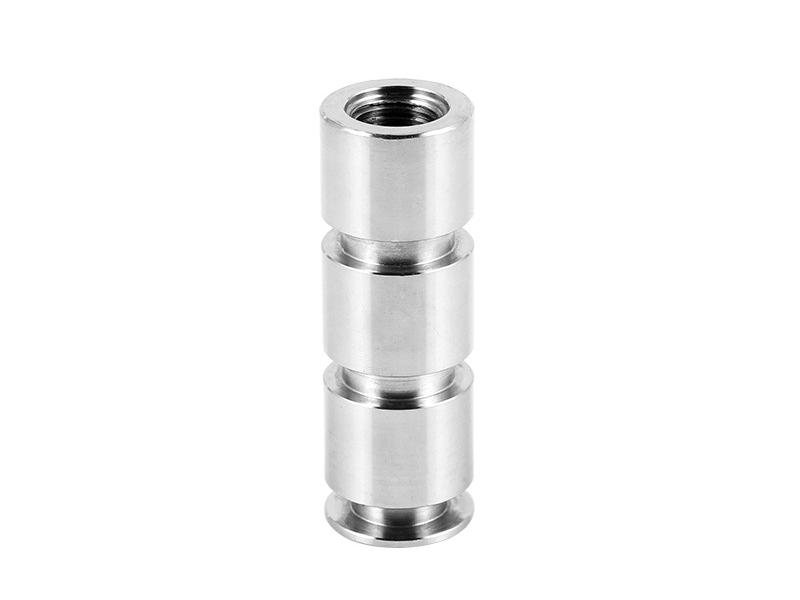CNC Turning of Stainless Steel Components for Robotics and Automation Systems
Precision Meets Durability in High-Cycle Applications
Robotics and automation systems demand components that survive millions of cycles under dynamic loads while maintaining micron-level precision. Stainless steels are chosen for 70% of critical robotic joints and actuators due to their corrosion resistance and fatigue strength. Multi-axis CNC turning services produce harmonic drive flex splines, actuator shafts, and sensor housings with ±0.005mm tolerances, essential for sub-arcminute positioning accuracy.
Collaborative robots (cobots) operating in humid environments require materials like Stainless Steel 17-4PH paired with PVD coatings to prevent galvanic corrosion while achieving 1,300 MPa yield strength for payload capacities up to 20kg.
Material Selection: Optimizing Strength-to-Weight Ratios
Material | Key Metrics | Robotics Applications | Limitations |
|---|---|---|---|
1,310 MPa YS, 35 HRC | Robotic wrist joints, servo shafts | Requires solution treatment pre-machining | |
485 MPa YS, Ra <0.4μm post-electropolish | Surgical robot components | Lower hardness than precipitation-hardened grades | |
62 HRC, 1,800 MPa UTS | Bearing races, gripper jaws | Brittle in < -20°C environments | |
690 MPa UTS, 35% improved machinability | Non-critical brackets, housings | Reduced corrosion resistance vs 316 |
Material Selection Protocol
High-Precision Actuators
Rationale: 17-4PH in H1150M condition provides 1,000 MPa yield strength with 15% elongation, enabling complex thin-walled flex spline geometries. Post-machining gas nitriding achieves 65 HRC surface hardness for a 10⁹ cycle lifespan.
Validation: ISO 9283 repeatability testing shows ±0.01mm positional accuracy after 5 million cycles.
Medical/Semiconductor Robots
Logic: 316L’s electropolished surface (Ra 0.2μm) prevents bacterial adhesion and particle generation, which is critical for ISO Class 5 cleanrooms.
Heavy-Duty Grippers
Strategy: 440C hardened to 60 HRC withstands 2,000N clamping forces while resisting abrasive wear from carbon fiber composites.
CNC Machining Process Optimization
Process | Technical Specifications | Applications | Advantages |
|---|---|---|---|
0.003mm diameter tolerance, 12,000 RPM | Micro lead screws (Ø1-5mm) | Eliminates secondary grinding | |
ISO 9409-1 mounting plates, 0.02mm pitch | Robot flange interfaces | 3x faster than single-point threading | |
55 HRC, Ra 0.8μm | Harmonic drive components | Replaces EDM (cost reduction 40%) | |
0.1mm width, 0.005mm depth consistency | Encoder disk patterns | Enables 0.001° angular resolution |
Process Workflow for Robotic Wrist Joints
Solution Treatment: 1,040°C×4h to dissolve intermetallic phases
Rough Turning: Remove 85% material with CBN inserts (2mm DOC, 180 m/min)
Aging: H900 condition (480°C×4h) to achieve target hardness
Finish Machining: Diamond-turned surfaces (Ra 0.1μm) for seal interfaces
Surface Engineering: Enhancing Functional Performance
Treatment | Technical Parameters | Robotics Benefits | Standards |
|---|---|---|---|
2μm thickness, friction coefficient 0.08 | Reduces stiction in linear guides | ISO 20523 | |
25μm composite, 0.12 CoF | Self-lubricating bushings | ASTM B733 | |
50μm dimples, 30% area coverage | Improved grease retention in gears | VDI 3400 | |
30μm thickness, 500V dielectric strength | Insulating layers for sensor housings | MIL-A-8625 Type II |
Coating Selection Logic
Collaborative Joints: DLC coatings reduce startup friction by 60%, enabling smooth human-robot interaction.
Food Handling Robots: Electroless Ni-PTFE passes FDA 21 CFR 175.300 for incidental food contact.
Outdoor Automation: Laser-textured 316L surfaces retain protective greases for IP67 compliance.
Quality Control: Robotics-Grade Validation
Stage | Critical Parameters | Methodology | Equipment | Standards |
|---|---|---|---|---|
Material Certification | Non-metallic inclusions (ASTM E45 ≤1.5) | Automated SEM/EDS analysis | Zeiss Sigma 300 | ISO 4967 |
Dimensional Inspection | Concentricity ≤0.005mm | Ultra-precision CMM | Mitutoyo Crysta-Apex S | ISO 10360-2 |
Cyclic Testing | 10⁷ cycles @200% rated load | Servo-hydraulic test rigs | MTS Landmark 250kN | ISO 10243 |
Surface Analysis | Sub-micron waviness (Wa <0.05μm) | White light interferometry | Bruker ContourGT-K | ASME B46.1 |
Certifications:
ISO 13849 functional safety compliance
CE and UL certification for collaborative systems
Industry Applications
Delta Robot Arms: 17-4PH + DLC coating (0.1μm Ra)
AGV Wheel Hubs: 316L + laser texturing (IP69K rating)
SCARA Z-Axis Guides: 440C + electroless Ni-PTFE (0.08 CoF)
Conclusion
Precision CNC turning services enable stainless steel robotics components to achieve 0.005mm positional repeatability while withstanding 10⁷+ operational cycles. Our ISO-certified machining ensures compliance with collaborative robot safety standards.
FAQ
Why choose 17-4PH over 304 for robotic joints?
How does DLC coating improve cobot performance?
What certifications apply to medical robotics?
How to prevent galling in stainless steel threads?
Cost comparison: Hard turning vs grinding for gears?

